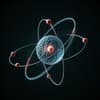Podcast
Questions and Answers
What is the primary function of a monochromator?
What is the primary function of a monochromator?
- To filter out specific wavelengths of light
- To amplify light intensity
- To convert monochromatic light to polychromatic light
- To separate polychromatic light into individual wavelengths (correct)
Which component of a monochromator creates a parallel beam after the entrance slit?
Which component of a monochromator creates a parallel beam after the entrance slit?
- Camera mirror
- Diffraction grating
- Collimating mirror (correct)
- Exit slit
Which of the following is NOT one of the basic components of a monochromator?
Which of the following is NOT one of the basic components of a monochromator?
- Exit slit
- Diffraction grating
- Entrance slit
- Prism (correct)
What is the role of the diffraction grating in a monochromator?
What is the role of the diffraction grating in a monochromator?
How many main types of monochromators are there?
How many main types of monochromators are there?
What is the function of a cuvette in the given setup?
What is the function of a cuvette in the given setup?
Which type of lamp provides power in the 320 to 800 nm range?
Which type of lamp provides power in the 320 to 800 nm range?
What is the main function of a photodetector in the system?
What is the main function of a photodetector in the system?
Which of the following is a type of wavelength selector?
Which of the following is a type of wavelength selector?
What is one of the issues associated with using a tungsten filaments lamp?
What is one of the issues associated with using a tungsten filaments lamp?
What is the role of a microprocessor in the given system setup?
What is the role of a microprocessor in the given system setup?
What does the Beer-Lambert law relate to?
What does the Beer-Lambert law relate to?
What symbol is used to denote the intensity of light passing through the reference cell?
What symbol is used to denote the intensity of light passing through the reference cell?
If the intensity I is less than I0, what does it indicate?
If the intensity I is less than I0, what does it indicate?
Which value in the Beer-Lambert law equation represents the absorptivity?
Which value in the Beer-Lambert law equation represents the absorptivity?
According to the Beer-Lambert law, what is absorbance (A) proportional to?
According to the Beer-Lambert law, what is absorbance (A) proportional to?
Which equation correctly represents the relationship between absorbance (A) and transmittance (%T)?
Which equation correctly represents the relationship between absorbance (A) and transmittance (%T)?
What is a major advantage of using a grating over a prism in spectroscopy?
What is a major advantage of using a grating over a prism in spectroscopy?
Which of the following best describes a cuvette's purpose?
Which of the following best describes a cuvette's purpose?
Which law combines the principles of Lambert, Bouguer, Bunsen, Roscoe, and Beer?
Which law combines the principles of Lambert, Bouguer, Bunsen, Roscoe, and Beer?
According to Beer-Lambert law, what is the relationship between the concentration of a solution and its absorbance?
According to Beer-Lambert law, what is the relationship between the concentration of a solution and its absorbance?
What elements are involved in a grating spectrometer?
What elements are involved in a grating spectrometer?
What happens to the intensity of light as it passes through a sample with higher absorbance?
What happens to the intensity of light as it passes through a sample with higher absorbance?
Which factor does not contribute to the efficiency of gratings over prisms?
Which factor does not contribute to the efficiency of gratings over prisms?
What is the result of the interaction between a patient specimen and reagent in a sample?
What is the result of the interaction between a patient specimen and reagent in a sample?
What is the main purpose of wavelength selectors?
What is the main purpose of wavelength selectors?
Which of the following filters absorb in the higher wavelength visible range?
Which of the following filters absorb in the higher wavelength visible range?
What is the primary function of a collimator lens in a spectrometer?
What is the primary function of a collimator lens in a spectrometer?
Which element of a spectrometer is responsible for separating light based on its wavelengths?
Which element of a spectrometer is responsible for separating light based on its wavelengths?
What type of filter is designed to be low-pass, high-pass, or band-pass?
What type of filter is designed to be low-pass, high-pass, or band-pass?
Which component of a spectrometer focuses the spectrum onto a detector?
Which component of a spectrometer focuses the spectrum onto a detector?
What is the function of the exit slit in a spectrometer?
What is the function of the exit slit in a spectrometer?
Interference filters are named after which aspect?
Interference filters are named after which aspect?
What component of a UV-visible spectrophotometer selects a specific wavelength of light?
What component of a UV-visible spectrophotometer selects a specific wavelength of light?
Which light source is commonly used in the visible region (400-800 nm) for spectrophotometry?
Which light source is commonly used in the visible region (400-800 nm) for spectrophotometry?
Which component in the UV-visible spectrophotometer holds the sample being analyzed?
Which component in the UV-visible spectrophotometer holds the sample being analyzed?
Which of the following ranges is covered by the ultraviolet light in spectrophotometry?
Which of the following ranges is covered by the ultraviolet light in spectrophotometry?
What is the function of the detector in the spectrophotometer?
What is the function of the detector in the spectrophotometer?
Which is NOT a component of the basic UV-visible spectrophotometer?
Which is NOT a component of the basic UV-visible spectrophotometer?
Why are LEDs becoming popular in spectrophotometry?
Why are LEDs becoming popular in spectrophotometry?
In which application area of spectrophotometry would one study the rate of a chemical reaction?
In which application area of spectrophotometry would one study the rate of a chemical reaction?
What role does the monochromator play in a UV-visible spectrophotometer?
What role does the monochromator play in a UV-visible spectrophotometer?
Which substance is most likely to emit light in the infrared region, often used in spectrophotometers?
Which substance is most likely to emit light in the infrared region, often used in spectrophotometers?
According to the Beer-Lambert Law, which variable represents the molar absorptivity?
According to the Beer-Lambert Law, which variable represents the molar absorptivity?
What happens to absorbance if the concentration of the solution is doubled?
What happens to absorbance if the concentration of the solution is doubled?
Which of the following describes a major assumption of Beer-Lambert Law?
Which of the following describes a major assumption of Beer-Lambert Law?
What does an absorbance of 0 at a specific wavelength indicate?
What does an absorbance of 0 at a specific wavelength indicate?
Why is it important to correct absorbance measurements for the concentration of the sample?
Why is it important to correct absorbance measurements for the concentration of the sample?
Which of the following is NOT a limitation of spectrophotometry?
Which of the following is NOT a limitation of spectrophotometry?
In spectrophotometry, what would likely happen if a solution is too dilute?
In spectrophotometry, what would likely happen if a solution is too dilute?
Which research application is commonly associated with spectrophotometry?
Which research application is commonly associated with spectrophotometry?
What is the unit of molar absorptivity?
What is the unit of molar absorptivity?
In Beer's Law, which variable represents concentration?
In Beer's Law, which variable represents concentration?
If the path length is doubled and the absorbance is kept constant, what happens to the concentration?
If the path length is doubled and the absorbance is kept constant, what happens to the concentration?
Which of the following is a typical application of spectrophotometry?
Which of the following is a typical application of spectrophotometry?
What was the concentration of guanosine found in the example calculation?
What was the concentration of guanosine found in the example calculation?
Which of the following is not a limitation of spectrophotometry?
Which of the following is not a limitation of spectrophotometry?
What is Beer's Law equation?
What is Beer's Law equation?
What factor influences the proportion of light absorbed by a solution?
What factor influences the proportion of light absorbed by a solution?
Flashcards are hidden until you start studying
Study Notes
Definition of Spectrophotometry
- A scientific method that measures the absorption of light by a substance at different wavelengths.
- Wavelengths range from ultraviolet (200-400 nm), visible (400-700 nm), or near infrared (700-800 nm).
Basic Principle of Spectrophotometry
- Measures the concentration of solutes in a solution by measuring the amount of light absorbed.
- Uses a cuvette placed in a spectrophotometer.
Basic Components of UV-Visible Spectrophotometer
- Light source: Emits light in the desired wavelength range (e.g., deuterium lamp for UV region, tungsten halogen lamp for visible region).
- Monochromator: Selects a specific wavelength of light (e.g., filter, prism, gratings).
- Entrance slit: Determines the width of the light beam.
- Dispersive element: Separates the light into different wavelengths.
- Exit slit: Allows only the selected wavelength to pass through.
- Sample cell (cuvette): Contains the sample being analyzed (made of glass, plastic, or quartz).
- Detector: Measures the amount of light that passes through the sample.
Components of UV-Visible Spectrophotometer
- Source: Provides a beam of light.
- Filter (optional): Selects a specific wavelength range.
- Fiber: Guides the light from the source to the cuvette.
- Cuvette: Holds the sample being analyzed.
- Photodetector: Detects the light that passes through the sample.
- Readout: Displays the data.
- Microprocessor: Processes the data.
- Recorder: Records the data.
Sources of Light
- Hydrogen lamp: Emits light in the infrared region and is often used in spectrophotometers that measure absorbance in the ultraviolet region.
- Tungsten filament lamp: Produces visible light and is used in spectrophotometers that measure absorbance in the visible region.
- LED: Energy-efficient and has a long lifespan.
Applications of Spectrophotometry
- Quantitative analysis: Determines the concentration of a substance in a solution.
- Qualitative analysis: Identifies the presence of a substance in a solution.
- Kinetics: Studies the rate of a chemical reaction.
- Biochemistry: Studies the properties of proteins, enzymes, and other biological molecules.
- Environmental monitoring: Measures the levels of pollutants in the environment.
Component Functions
- Source of light: Electromagnetic waves.
- Filter/prism: Spectral isolation.
- Fiber optic: Directional control of the beam.
- Cuvette: Holds the liquid analyte.
- Photodetector: Amplification of the signal.
- Readout device: Digital reading.
- Microprocessor: Calculates the concentration.
- Recorder: Gives the result.
Wavelength Selectors
- Monochromators: Devices that separate light based on its wavelengths.
- Filters: Glass or interference filters that absorb power for specific wavelengths.
Monochromators
- Prisms: Refraction of sunlight.
- Grating spectrometer: Source, grating, mirrors, detector.
Cuvettes
- Definition: A small rectangle, round, or square vessel.
- Function: Holds the substance being analyzed and maintains the optical characteristic.
Samples
- A sample substance results from the interaction between a patient specimen and reagent.
- Absorbs light selectively according to the law of Lambert, Bouguer, Bunsen, Roscoe, and Beer's Law.
Beer's Law
- States that there is a linear relationship between the concentration of a solution and the absorbance of the solution.
- Enables the concentration of a solution to be calculated by measuring its absorbance.
Absorbance of a Sample
- The intensity of the light passing through the sample is referred to as the absorbance.
- The intensity of light passing through the sample is dependent on the sample's absorbance.
- Reflected in the cuvette surface.
The Importance of Concentration
- The proportion of the light absorbed depends on how strongly it interacts with the sample.
- Concentrated solutions have higher absorbance, while dilute solutions have lower absorbance.
Limitations of Spectrophotometry
- Restriction to the solution phase only.
- Cost: Spectrophotometers can be expensive.
- Low sensitivity and selectivity.
Studying That Suits You
Use AI to generate personalized quizzes and flashcards to suit your learning preferences.





